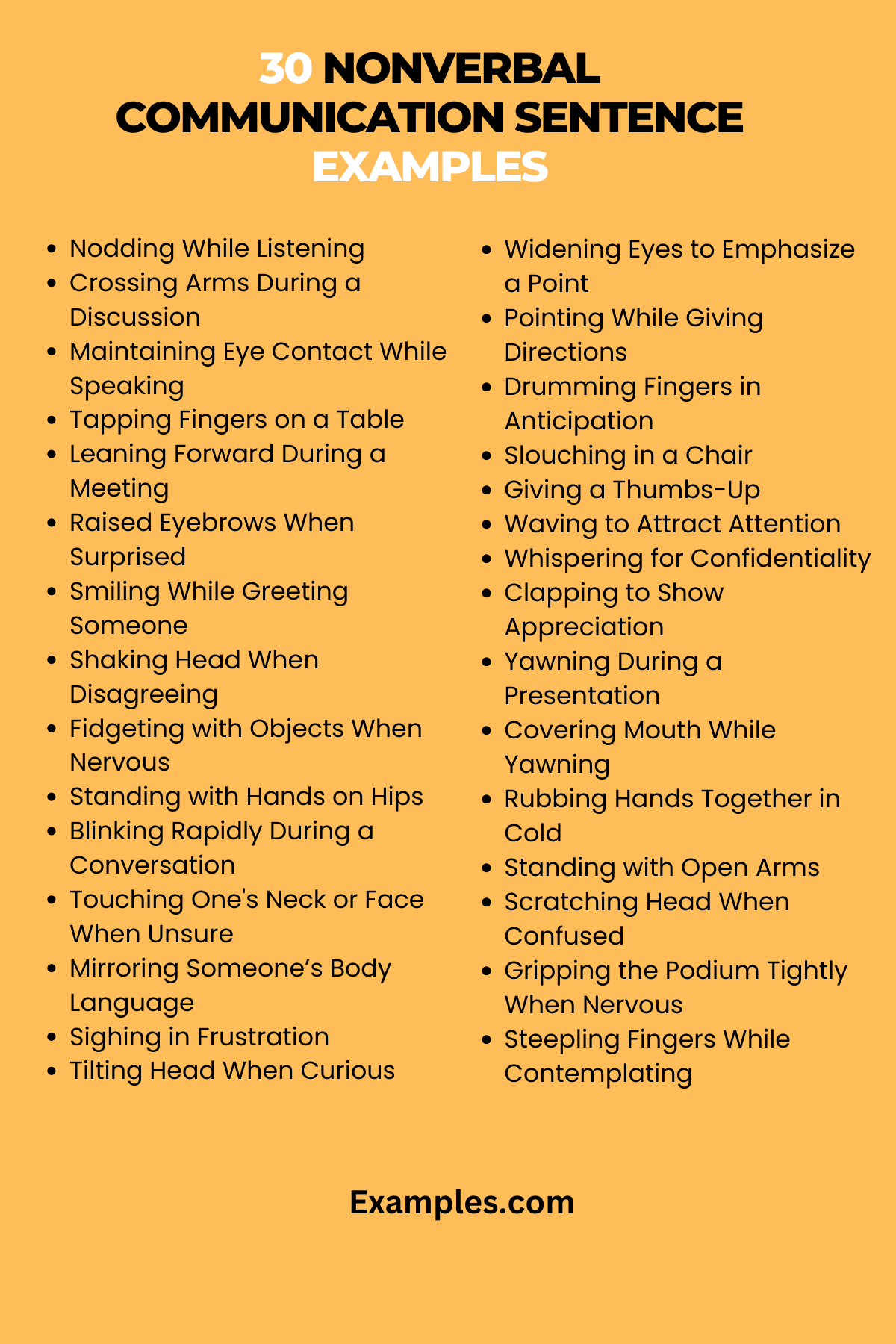29+ Nonverbal Communication Sentence Examples
Nonverbal communication, often overshadowed by verbal interactions, holds immense power in conveying messages. This guide delves into the intricate world of unspoken cues, offering insightful Nonverbal Communication Examples. From subtle facial expressions to impactful body language, we explore various forms that go beyond words. Understanding these nonverbal signals enhances interpersonal connections, making this guide essential for effective communication. Whether in professional settings or personal interactions, mastering nonverbal communication is key to a deeper understanding of human behavior.
What is a Sentence for Nonverbal Communication? – Definition
Nonverbal communication refers to the process of conveying a message without the use of spoken words. It encompasses a range of physical behaviors and visual cues, including facial expressions, body language, gestures, and eye contact. Unlike verbal communication, which relies on words and speech, nonverbal communication often conveys emotions and intentions through subtle, silent signals. It plays a crucial role in enhancing the meaning of verbal messages and can sometimes convey a different message entirely. Understanding nonverbal communication is essential for effective interpersonal interactions, as it forms a significant part of human communication.
30 Nonverbal Communication Sentence Examples
Nonverbal communication is an essential component of effective interaction, with its subtle nuances often conveying more than words. This compilation of 30 Nonverbal Communication Sentence Examples showcases the diverse ways nonverbal cues like facial expressions and body language can be utilized in everyday scenarios. Each example, highlighted in bold, is explained in detail, providing insights into how these silent forms of communication can express emotions, intentions, and reactions. These examples span various settings, from professional to personal, illustrating the powerful impact of nonverbal communication in our daily lives.

- Nodding while listening: Indicates agreement or understanding in a conversation, showing attentiveness and engagement.
- Crossing arms during a discussion: Often signifies defensiveness or a closed-off attitude, possibly indicating disagreement or discomfort.
- Maintaining eye contact while speaking: Shows confidence and honesty, fostering trust in professional and personal interactions.
- Tapping fingers on a table: Can signal impatience or boredom, suggesting a desire to expedite the conversation or situation.
- Leaning forward during a meeting: Implies interest and eagerness, demonstrating active participation in the discussion.
- Raised eyebrows when surprised: Expresses shock or disbelief, accentuating the emotional response to unexpected news or situations.
- Smiling while greeting someone: Conveys warmth and friendliness, creating a positive and welcoming atmosphere.
- Shaking head when disagreeing: A universal sign of disapproval or negation, clearly communicating non-acceptance of the idea or suggestion.
- Fidgeting with objects when nervous: Indicates stress or anxiety, often observed in high-pressure environments.
- Standing with hands on hips: Can denote assertiveness or readiness, commonly seen in situations requiring control or leadership.
- Blinking rapidly during a conversation: May signal discomfort or a lack of confidence in what is being discussed.
- Touching one’s neck or face when unsure: Reflects uncertainty or self-doubt, typically seen in moments of indecision.
- Mirroring someone’s body language: Demonstrates empathy and rapport-building, often used subconsciously to create connection.
- Sighing in frustration: Audibly expresses irritation or exasperation, signaling dissatisfaction with the current scenario.
- Tilting head when curious: Shows interest and a desire for further information, commonly observed in engaging conversations.
- Widening eyes to emphasize a point: Enhances the importance of a statement or reaction, adding emphasis without words.
- Pointing while giving directions: Offers clear, nonverbal guidance, aiding in spatial understanding and instruction.
- Drumming fingers in anticipation: Reflects excitement or eagerness, often preceding an awaited event or moment.
- Slouching in a chair: Can indicate disengagement or lack of enthusiasm, often seen in unstimulating or tedious situations.
- Giving a thumbs-up: A universally recognized gesture of approval or success, frequently used in casual and formal scenarios alike.
- Waving to attract attention: A simple yet effective way to nonverbally signal someone, commonly used in both personal and public settings.
- Whispering for confidentiality: Indicates the need for discretion, often used in environments where privacy is required.
- Clapping to show appreciation: A common gesture of approval and praise, typically seen in celebratory or acknowledgement contexts.
- Yawning during a presentation: Involuntarily communicates tiredness or boredom, often perceived negatively in professional environments.
- Covering mouth while yawning: Shows consideration and manners, attempting to minimize the potentially negative impression of yawning.
- Rubbing hands together in cold: A nonverbal indication of physical discomfort due to temperature, universally understood.
- Standing with open arms: Suggests openness and receptiveness, often used to welcome or invite interaction.
- Scratching head when confused: Visually represents puzzlement or the need for clarification, a common response in uncertain situations.
- Gripping the podium tightly when nervous: Reflects anxiety or nervousness, especially observed in public speaking scenarios.
- Steepling fingers while contemplating: Denotes deep thought or consideration, often seen in decision-making processes.
Nonverbal Communication Meaning and Sentence
Nonverbal communication is the art of conveying messages without the use of spoken words. It involves a wide array of behaviors such as facial expressions, body movements, gestures, eye contact, posture, and even the tone of voice. In essence, nonverbal communication complements, contradicts, or enhances verbal communication. For instance, a sentence demonstrating this might be, “During the interview, her confident posture and steady eye contact complemented her verbal responses, showcasing her assurance.” This sentence highlights how nonverbal cues can reinforce spoken words, adding depth and clarity to the communication.
How do you Use Nonverbal Communication in a Sentence?
Using nonverbal communication effectively in a sentence involves describing actions or behaviors that convey a message without the need for words. For example, “As he listened, his nodding indicated agreement, while his folded arms suggested he was still somewhat reserved.” This sentence shows the dual nature of nonverbal cues – nodding signifies agreement, but folded arms may imply a degree of reservation or discomfort. Such sentences help in painting a more comprehensive picture of a person’s response or feelings, going beyond what is verbally expressed.
What is Nonverbal Communication Answer in a Sentence?
Nonverbal communication can be succinctly defined in a sentence as follows: “Nonverbal communication is the silent yet powerful language of gestures, facial expressions, and body language that conveys emotions and thoughts without words.” This sentence encapsulates the essence of nonverbal communication, highlighting its role in expressing unspoken but significant aspects of human interaction. It underscores the importance of nonverbal cues in understanding the full context of communication, beyond just the spoken word.

In conclusion, our exploration of Nonverbal Communication Sentence Examples and tips demonstrates the profound impact of nonverbal cues in everyday communication. This guide offers valuable insights into the nuances of facial expressions and body language, key aspects of nonverbal communication. By understanding and applying these principles, we can enhance our ability to convey and interpret messages more effectively, enriching both personal and professional interactions.



